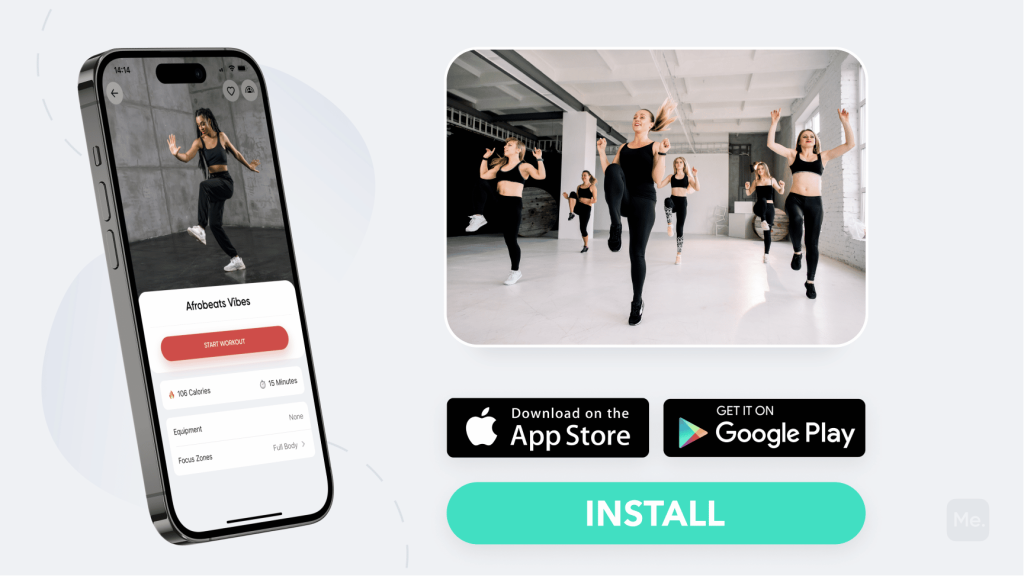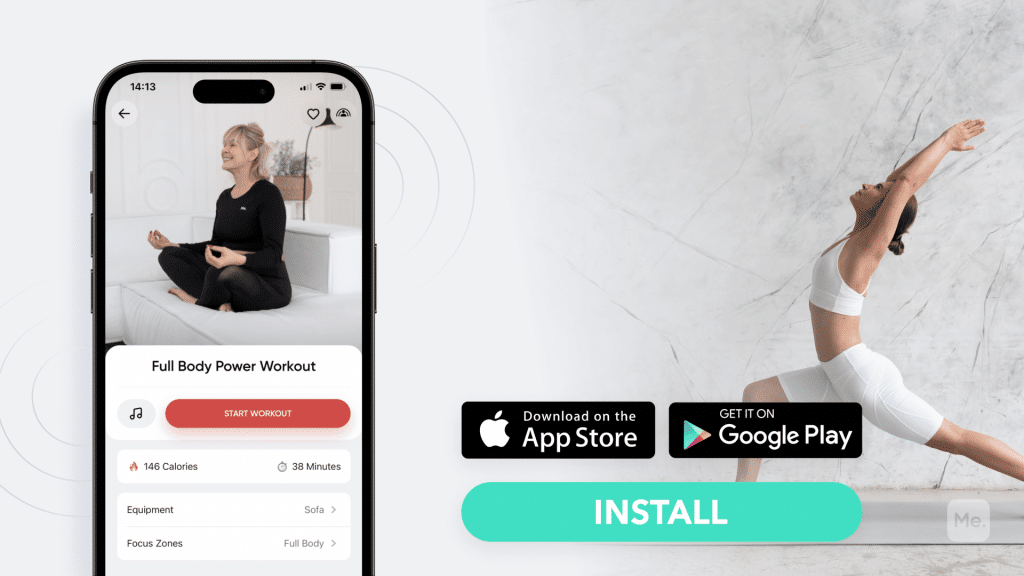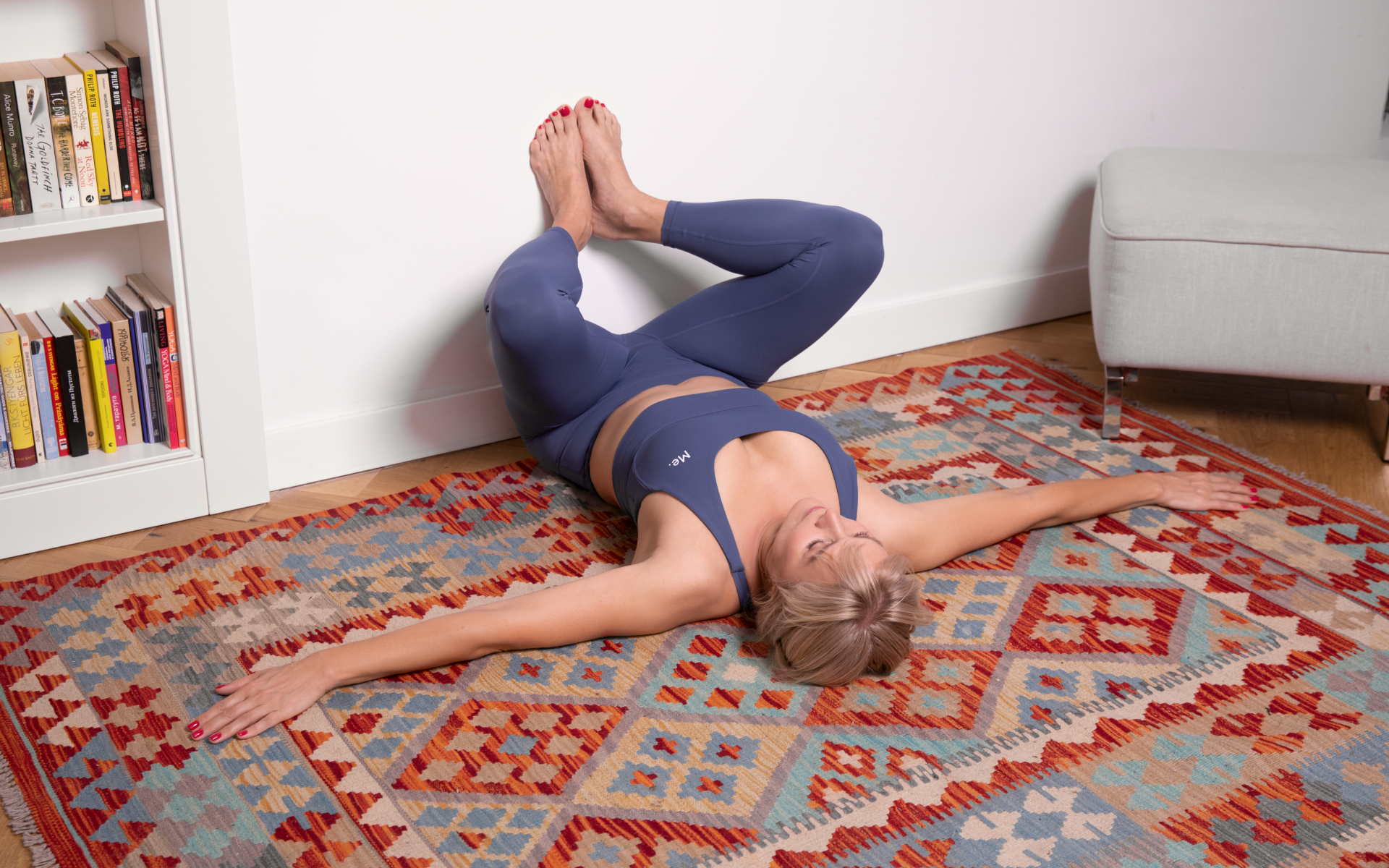According to traditional yoga philosophy, the body contains five primary energy centers (8).
Get your personalized
meal plan!
These are known as chakras, and each one corresponds to particular physical, mental, and spiritual functions. By opening these chakras with yoga poses that focus on relaxation, you can help restore your mind and body balance.
One chakra that can benefit from grounding poses is the root chakra, which is located at the base of your spine.
It is believed to be the energy center from which we draw our security and stability. When it’s out of balance, due to stress, fatigue, or any other external factor, we can often feel anxious and out of sorts (3).
Yoga poses done while lying on your back can help open your root chakra and promote a sense of peace and relaxation.
Here are some of our favorites:
Shanti Asana (aka Peace or Corpse Pose)
The word “Shanti” means peace in Sanskrit, and that is exactly what this pose offers. Essentially, it is mimicking the relaxation of a corpse but doing it with awareness. The idea is to give the mind and body total rest and relaxation.
To properly execute the Corpse Asan:
- Lie on your back on a flat surface.
- Place your arms at your sides without gripping them or tensing any muscles.
- Close your eyes and focus on your breathing. Notice how your body rises and falls with each inhalation and exhalation.
- Allow yourself to totally relax and let go, paying attention to any areas of tension that may arise. While breathing in, visualize calmness and serenity flowing through your body.
- Stay in this pose for 5 minutes or longer, then slowly roll to your right side. Rest your head on your folded right hand and your left hand on your left thigh.
- Breathe calmly through your left nostril (Chandra Swar) for a few minutes.
- After a few minutes, do the other side and gently roll to your left. Rest your head on your folded left hand and your right hand resting on your right thigh.
- Breathe calmly through your right nostril (Surya Swar) for a few minutes.
- Finally, come to a seated position, feeling more relaxed and peaceful.
Read More: 10 Different Yoga Poses to Relieve Upper Back Pain
Apanasana (aka Wind-Relieving or Knees to Chest)
The word “Apana” refers to the downward flow of energy, and this pose helps move stagnant energy through the body.
It also encourages relaxation while stretching and massaging the lower back. It’s commonly referred to as the “Wind-Relieving” pose because it is said to help release gas or bloating (7). By releasing tension in the lower back and abdominal area, it also helps to reduce stress (6).
To properly execute Apanasana:
- Lie on your back on a flat surface, while placing your arms by your sides.
- Breathe in deeply, and as you exhale, draw your knees into your chest, wrapping your hands gently around them.
- Hold the pose for a few breaths, releasing any tension and allowing your body to relax more deeply with each exhalation.
- Release your knees and return to the starting position, feeling a sense of relaxation in the lower back, hips, and abdomen.
Supta Baddha Konasana (aka Reclining Bound Angle Pose)
The word “Supta” means reclined or lying down, and “Baddha Konasana” is translated as a bound angle pose. This restorative pose helps open the hips and pelvis while calming the nervous system.
It combines the soothing effects of a reclined posture with the gentle opening of the inner thighs and groin. If you’ve been sitting for long periods or if you suffer from lower back pain, this pose can be especially helpful (9).
To execute Supta Baddha Konasana:
- Lie on your back and bring the soles of your feet together, letting your knees fall open like a book. You can place a rolled-up towel or blanket underneath your knees for extra support.
- Rest your hands on your belly and close your eyes, focusing on releasing any tension in the hips, groin, and inner thighs.
- Stay in this position for 5 minutes or longer, allowing the body to sink deeper into relaxation with each breath.
- To come out of the pose, slowly straighten your legs and roll to one side before pushing yourself back up into a seated position.
Tanasan
This lesser-known pose is a great way to relax and restore the body. It has no direct English translation but it’s simplified by picturing a lazy cat stretching after a long nap. Tanasan helps unwind the spine and release tension in the body while promoting feelings of calmness and relaxation.
To properly execute Tanasan:
- Lie on your back and stretch out your hands and legs as far as is comfortable.
- Allow your body to sink into the floor and feel any areas of tightness or tension slowly melting away.
- Stay in this position for at least 5 minutes, focusing on deep breathing and allowing your body to restore its natural balance.
- When you are ready, slowly roll onto one side before pushing yourself up into a seated position.
If you wish to free yourself from all the extra pounds that have been weighting you down for way too long, start using the BetterMe app and overhaul your entire life!
Anantasana
Lord Shri Krishna is traditionally depicted as sleeping in the Anantasana or “Sleeping Vishnu” pose. This relaxing, restorative posture encourages deep relaxation and helps calm the nervous system.
It stretches and strengthens the spine, as well as relieving tension in the lower back. Also called the “side reclining leg lift”, Anantasana lengthens the entire side of the body while calming and grounding the mind (4).
To properly execute Anantasana:
- Lie on your right side, supporting yourself with your right arm. Raise your head and place it on your right arm, or use a bolster or pillow for comfort.
- Raise your left leg up, making a 90-degree angle with the body, and hold it in position for at least 60 seconds.
- Breathe deeply, focusing on releasing any tension in the lower back and hip area.
- Move your left foot up and down to massage the area around the hip joint.
- Repeat for the other side and come back to a reclined position when you are done.
Uttan-Padasana (aka Raised Foot Pose)
“Uttan” means raised or elevated, and “Padasana” is translated as foot pose. This simple restorative posture helps ease tension in the lower back, hips, and abdomen. It’s a great pose for those who experience lower back pain or fatigue in the legs (9).
To properly execute Uttan-Padasana:
- Lie on your back and bring both legs up, keeping the knees bent and in line with the hips.
- Interlock your fingers and press the back of your palms into your thighs, gently pushing them toward the chest.
- Stay in this position for at least 5 minutes, focusing on deep breathing and allowing your body to restore its natural balance.
- To come out of the pose, slowly lower your legs back to the floor and roll onto one side before pushing yourself up into a seated position.
Naukasana
Naukasana, or the boat pose, helps to stretch and strengthen the core muscles.
It is believed to relieve stress and fatigue while improving digestion and circulation. It’s also thought to reduce anxiety and depression, allowing the body to relax into a peaceful state (5).
To properly execute Naukasana:
- Lie on your back and bring both knees toward your chest.
- Extend your arms straight out in front of you, and then slowly lift your head, chest, and legs off the ground.
- Your body should form a “V” shape, with your arms and legs making the two sides.
- Focus on deep breathing and hold this position for at least 10 seconds.
- To come out of the pose, slowly lower your legs back to the floor and roll onto one side before pushing yourself up into a seated position.
Supta Matsyendrasan (aka Reclined Spinal Twist)
Matsyendrasanath was a famous yogic sage who popularized this restorative posture.
Supta Matsyendrasan is a powerful twist that helps to open the chest and back while grounding and calming the body. It’s a great pose for those who experience lower back pain or fatigue in the legs (9).
To properly execute Supta Matsyendrasan:
- Lie on your back and bring both knees toward your chest.
- Cross your left leg over your right knee, so that the left foot is resting on the floor.
- Gently draw your knees towards the opposite shoulder and hold for at least 30 seconds.
- Switch sides and repeat the pose on the other side.
- To come out of the pose, slowly lower your legs back to the floor and roll onto one side before pushing yourself up into a seated position.
Read More: 10 Effective Yoga Poses for Bloating
Setubandhasan (aka Bridge Pose)
The word Setu Bandhasana is derived from two Sanskrit words, “setu” meaning bridge, and “bandha” meaning lock or posture. This is a restorative posture that helps to open the chest and back while calming the mind.
It’s great for relieving tension in the neck, shoulders, and spine, as well as relieving stress (2).
To properly execute Setu Bandhasana:
- Lie on your back with your knees bent and feet flat on the floor.
- Press your feet and arms firmly into the ground as you lift your hips off the floor.
- Lift your chest and shoulders towards the sky, extending your arms above your head.
- Hold this position for at least 10 seconds, focusing on deep breathing.
- To come out of the pose, slowly lower your hips back to the floor and roll onto one side before pushing yourself up into a seated position.
Sarvangasana (aka Shoulder Stand)
Sarvangasan is a restorative inversion that helps tone the entire body.
It’s a complex posture that requires strength and balance, but it can also be a great way to reduce stress and fatigue. It’s believed to improve digestion and circulation, while also calming and relaxing the mind (1).
To properly execute Sarvangasan:
- Lie on your back and bring both knees toward your chest.
- Raise your legs, hips, and torso off the ground until your body forms a straight line from head to toe.
- Place your hands flat on the floor at the base of your spine for support.
- Hold this position for at least 10 seconds, focusing on deep breathing.
- To come out of the pose, slowly lower your legs back to the floor and roll onto one side before pushing yourself up into a seated position.
Halasan (aka Plough Pose)
Halasan is a relaxing pose that helps to open the chest and back while calming the mind. It’s a great posture that can improve digestion, circulation, and respiratory health. It can also help relieve tension in the neck and shoulders (10).
To properly execute Halasan:
- Lie on your back and bring both knees toward your chest.
- Raise both legs over your head until they are parallel to the floor.
- Place your hands flat on the floor at the base of your spine for support.
- Hold this position for at least 10 seconds, focusing on deep breathing.
- To come out of the pose, slowly lower your legs back to the floor and roll onto one side before pushing yourself up into a seated position.
Yanking yourself back in shape has never been so easy with our game-changing fitness app! Start transforming your life with BetterMe!
The Bottom Line
Performing different yoga poses on the back can help to open the chest and back, while also calming the mind. These restorative poses are a great way to reduce stress, fatigue, and tension, while also improving circulation and respiratory health. However, it is important to remember to take it slow and focus on your breathing as you perform each pose.
DISCLAIMER:
This article is intended for general informational purposes only and does not serve to address individual circumstances. It is not a substitute for professional advice or help and should not be relied on for making any kind of decision-making. Any action taken as a direct or indirect result of the information in this article is entirely at your own risk and is your sole responsibility.
BetterMe, its content staff, and its medical advisors accept no responsibility for inaccuracies, errors, misstatements, inconsistencies, or omissions and specifically disclaim any liability, loss or risk, personal, professional or otherwise, which may be incurred as a consequence, directly or indirectly, of the use and/or application of any content.
You should always seek the advice of your physician or other qualified health provider with any questions you may have regarding a medical condition or your specific situation. Never disregard professional medical advice or delay seeking it because of BetterMe content. If you suspect or think you may have a medical emergency, call your doctor.
SOURCES:
- Benefits of Sarvangasana (Shoulder Stand) and How to Do it By Dr. Himani Bisht (2022, pharmeasy.in)
- Bridge Pose (Setu Bandhasana) (n.d., artofliving.org)
- Eastern Integrative Medicine and Ancient Sound Healing Treatments for Stress: Recent Research Advances (2020, imjournal.com)
- Effects of hatha yoga exercises on spine flexibility in women over 50 years old (2015, nih.gov)
- Efficacy of yoga therapy on subjective well-being and basic living skills of patients having chronic schizophrenia (2012, nih.gov)
- Exploring the therapeutic effects of yoga and its ability to increase quality of life (2011, nih.gov)
- Irritable Bowel Syndrome: Yoga as Remedial Therapy (2015, nih.gov)
- Pancha Bhutas: Yoga’s 5 Elements of Nature (n.d., yogabasics.com)
- Physical and Physiological Effects of Yoga for an Underserved Population with Chronic Low Back Pain (2019, nih.gov)
- The Impacts of Pilates and Yoga on Health-Promoting Behaviors and Subjective Health Status (2021, nih.gov)












